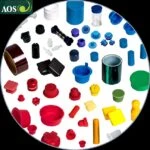 Once you choose injection molding, you must focus on reducing the costs as much as possible. ABS stands for acrylonitrile butadiene styrene. ABS is common in injection molding since it is inexpensive and easy to mold.
Once you choose injection molding, you must focus on reducing the costs as much as possible. ABS stands for acrylonitrile butadiene styrene. ABS is common in injection molding since it is inexpensive and easy to mold.
Acrylonitrile butadiene styrene is a thermoplastic polymer used to manufacture electronic pieces and consumer goods. Unlike other injection molding molds, ABS does not do well when exposed to sunlight and other weather conditions.
However, manufacturers add some elements during polymer injection molding to improve the ABS quality. These additives make ABS injection molding more weather resistant, thus increasing use outdoors.
Before learning how the ABS injection molding process occurs, here’s more about ABS plastics.
What are ABS Plastics?
ABS plastics are amorphous thermoplastics without a true melting point. They are opaque and highly resistant to impact. That’s why ABS is very popular with injection molding.
The acrylonitrile makes the plastic chemical and heat resistant. In addition, butadiene in ABS plastics imparts toughness, making the polymer impact-resistance. The styrene ensures the plastic is glossy and strong.
When you burn ABS, it does not burn. Instead, it becomes a liquid, making it easier to inject into molds. This feature makes ABS popular in injection molding.
Properties of ABS Plastics
Before choosing a polymer for injection molding, it helps to evaluate the features of the plastic. Thereafter, you can decide if it is suitable or unsuitable for the intended use.
Here are properties of ABS that make it workable in many industries:
- Chemical and heat resistant
- Resistant to staining, impact, and abrasion
- Has a 6600 PSI tensile strength
- Has a 0.5 to 0.7% shrink rate
- Has a specific gravity
- Has a constant temperature between 204 to 238 °C
Why Choose ABS Plastics for Injection Molding?
There are several polymers usable in injection molding. However, ABS plastic molding is popular in various industries due to the following advantages:
- Flexibility
ABS plastic molding is applicable in several ways. First, the process allows manufacturers to work with many resins, varying in strength and size. Therefore, they produce components usable in many industries.
- Energy Efficiency
Machines used in the injection molding process of ABS plastics are highly efficient. Since they work repetitively to produce similar end products, they save energy. Therefore, these machines become energy efficient and maintain optimum cycle times during production.
- Accuracy
ABS injection molding ensures the production of parts used for complex applications. Complementary techniques and regulated injection molding practices ensure these parts are accurate and use-specific.
ABS is better for use during injection molding because it does not lose its characteristics or performance. It does not matter the temperature levels you expose the polymer to.
Factors to Consider in the ABS Injection Molding Process
Before a manufacturer settles on ABS injection molding, they must consider some factors. These factors help to make the molding process more successful. They include:
- The design of ABS plastic parts
- Molding temperature
- Injection pressure
- State of ABS material before processing
- Molding speed during injection
Applications of ABS Plastic Molding
There are several materials made using ABS plastics. They are usable in commercial and industrial setups. Their low melting point and low cost make them popular among many manufacturers. Industries that prefer ABS plastics include automotive, electrical, and construction industries. Some ABS plastics also make musical instruments and medical devices.
While looking for a polymer for injection molding, you’ll find that ABS is the most common. Its features, such as heat resistance and durability, make it a better polymer. With ABS, you spend less in production and get several benefits on top of the versatility involved.
0


